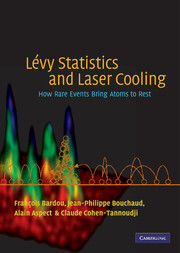Book contents
- Frontmatter
- Contents
- Foreword
- Acknowledgements
- 1 Introduction
- 2 Subrecoil laser cooling and anomalous random walks
- 3 Trapping and recycling. Statistical properties
- 4 Broad distributions and Lévy statistics: a brief overview
- 5 The proportion of atoms trapped in quasi-dark states
- 6 The momentum distribution
- 7 Physical discussion
- 8 Tests of the statistical approach
- 9 Example of application: optimization of the peak of cooled atoms
- 10 Conclusion
- Appendix A Correspondence between parameters of the statistical models and atomic and laser parameters
- Appendix B The Doppler case
- Appendix C The special case µ = 1
- References
- Index of main notation
- Index
8 - Tests of the statistical approach
Published online by Cambridge University Press: 06 July 2010
- Frontmatter
- Contents
- Foreword
- Acknowledgements
- 1 Introduction
- 2 Subrecoil laser cooling and anomalous random walks
- 3 Trapping and recycling. Statistical properties
- 4 Broad distributions and Lévy statistics: a brief overview
- 5 The proportion of atoms trapped in quasi-dark states
- 6 The momentum distribution
- 7 Physical discussion
- 8 Tests of the statistical approach
- 9 Example of application: optimization of the peak of cooled atoms
- 10 Conclusion
- Appendix A Correspondence between parameters of the statistical models and atomic and laser parameters
- Appendix B The Doppler case
- Appendix C The special case µ = 1
- References
- Index of main notation
- Index
Summary
Motivation
As explained in Chapter 2, the Lévy statistics treatment of subrecoil laser cooling has been introduced after a series of simplifications, where we have dropped details of the quantum microscopic description to only keep the main features of the physical process. Such a way of reasoning is standard in statistical physics. It is difficult, however, to be sure a priori that one has not dropped important features, and the validity of the statistical approach needs to be checked. An important step of this verification, although not a rigorous proof, is to compare a posteriori the predictions of the statistical approach with experimental results as well as with the predictions of microscopic theoretical approaches. This chapter presents such comparisons.
We present in Section 8.2 the approaches (theoretical and experimental) to which our statistical approach can be compared. We then proceed to compare the results obtained by the different approaches. First, in Section 8.3, we treat in detail the predictions for a global quantity, the proportion of trapped atoms. This is done for the three recycling models introduced in this work, in the one-dimensional case. Then, in Section 8.4, we study another physical quantity with a richer content, the momentum distribution of cooled atoms. In Section 8.5, we investigate the influence of the dimensionality of the problem, and the role of friction during the recycling periods – which are crucial predictions of the Lévy statistics analysis.
Information
- Type
- Chapter
- Information
- Lévy Statistics and Laser CoolingHow Rare Events Bring Atoms to Rest, pp. 101 - 123Publisher: Cambridge University PressPrint publication year: 2001
